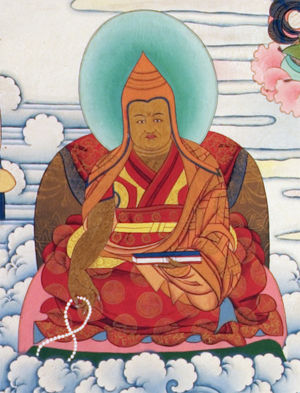Jamyang Loter Wangpo: Difference between revisions
mNo edit summary |
m (Already hyperlinked earlier) |
||
| (4 intermediate revisions by 3 users not shown) | |||
| Line 1: | Line 1: | ||
[[Image:Loter Wangpo-Shechen2 cal.jpg|thumb|300px|Jamyang Loter Wangpo, courtesy of Shechen Monastery]] | [[Image:Loter Wangpo-Shechen2 cal.jpg|thumb|300px|Jamyang Loter Wangpo, courtesy of Shechen Monastery]] | ||
'''Jamyang Loter Wangpo''' ([[Wyl.]] ''‘jam dbyangs blo gter dbang po'') aka '''Thartse Pönlop Loter Wangpo''' (1847-1914) — an important [[Rime]] [[Sakya]] master of [[Thartse|Ngor Thartse Monastery]] who played a key role in the [[Rimé]] movement. He was a disciple of [[Jamyang Khyentse Wangpo]] and a teacher of [[Jamyang Khyentse Chökyi Lodrö]]. He is well known for compiling the ''[[Compendium of Tantras]]'' under the inspiration of his guru, Jamyang Khyentse Wangpo as well as publishing the very first printed edition of the [[Explanation for Private Disciples]] of the [[Lamdre]] system of the [[Sakya]] School, which before that had been transmitted only orally and was tenuously preserved in manuscript form. Jamyang Loter Wangpo also received [[Dzogchen]] instructions from [[Nyoshul Lungtok]]. | '''Jamyang Loter Wangpo''' (Tib. འཇམ་དབྱངས་བློ་གཏེར་དབང་པོ་, [[Wyl.]] ''‘jam dbyangs blo gter dbang po'') aka '''Thartse Pönlop Loter Wangpo''' (1847-1914) — an important [[Rime]] [[Sakya]] master of [[Thartse|Ngor Thartse Monastery]] who played a key role in the [[Rimé]] movement. He was a disciple of [[Jamyang Khyentse Wangpo]] and a teacher of [[Jamyang Khyentse Chökyi Lodrö]]. He is well known for compiling the ''[[Compendium of Tantras]]'' under the inspiration of his guru, Jamyang Khyentse Wangpo as well as publishing the very first printed edition of the [[Explanation for Private Disciples]] of the [[Lamdre]] system of the [[Sakya]] School, which before that had been transmitted only orally and was tenuously preserved in manuscript form. Jamyang Loter Wangpo also received [[Dzogchen]] instructions from [[Nyoshul Lungtok]]. The collection of 139 painted mandala thangkas for the ''Compendium of Tantras'' was saved in 1958 by [[Sonam Gyatso Thartse Khen Rinpoche]], and later published in more than one edition. | ||
==His Writings== | ==His Writings== | ||
In addition to his tantric works, Loter Wangpo composed commentaries to the ''[[Abhidharmakosha]]'' and [[Sakya Pandita]]'s ''[[Treasury of Valid Reasoning]]''. He composed a Dzogchen instruction manual (''khrid yig''), which, as [[Nyoshul Khen Rinpoche]] points out, concluded at the 'increase of experience' (''nyams gong 'phel''), the second of the [[four visions]], claiming that he had no personal experience of anything beyond that level.<ref>See Nyoshul Khen Rinpoche, ''A Marvelous Garland of Rare Gems: Biographies of Masters of Awareness in the Dzogchen Lineage'' (Junction City: Padma Publications, 2005), p. 243</ref> | In addition to his tantric works, Loter Wangpo composed commentaries to the ''[[Abhidharmakosha]]'' and [[Sakya Pandita]]'s ''[[Treasury of Valid Reasoning]]''. He composed a Dzogchen instruction manual (ཁྲིད་ཡིག་, ''khrid yig''), which, as [[Nyoshul Khen Rinpoche]] points out, concluded at the 'increase of experience' (ཉམས་གོང་འཕེལ་, ''nyams gong 'phel''), the second of the [[four visions]], claiming that he had no personal experience of anything beyond that level.<ref>See Nyoshul Khen Rinpoche, ''A Marvelous Garland of Rare Gems: Biographies of Masters of Awareness in the Dzogchen Lineage'' (Junction City: Padma Publications, 2005), p. 243</ref> | ||
==Notes== | ==Notes== | ||
| Line 10: | Line 10: | ||
==Further Reading== | ==Further Reading== | ||
===In Tibetan=== | ===In Tibetan=== | ||
*[[Dhongthog Rinpoche]], ''A History of the Sa-skya-pa Sect of Tibetan Buddhism'' (''byang phyogs thub pa'i rgyal tshab dpal ldan sa | *[[Dhongthog Rinpoche]], ''A History of the Sa-skya-pa Sect of Tibetan Buddhism'' (བྱང་ཕྱོགས་ཐུབ་པའི་རྒྱལ་ཚབ་དཔལ་ལྡན་ས་སྐྱ་པའི་བསྟན་པ་རིན་པོ་ཆེ་ཇི་ལྟར་བྱུང་བའི་ལོ་རྒྱུས་རབ་འབྱམས་ཞིང་དུ་སྙན་པའི་སྒྲ་དབྱངས་, ''byang phyogs thub pa'i rgyal tshab dpal ldan sa skya pa'i bstan pa rin po che ji ltar byung ba'i lo rgyus rab 'byams zhing du snyan pa'i sgra dbyangs''), New Delhi, 1977, pp. 308-329 | ||
==External Links== | ==External Links== | ||
* | *{{TBRC|P560|TBRC Profile}} | ||
[[Category:Historical Masters]] | [[Category:Historical Masters]] | ||
[[Category:Sakya Masters]] | [[Category:Sakya Masters]] | ||
[[Category:Rimé Masters]] | [[Category:Rimé Masters]] | ||
Latest revision as of 07:31, 3 January 2018

Jamyang Loter Wangpo (Tib. འཇམ་དབྱངས་བློ་གཏེར་དབང་པོ་, Wyl. ‘jam dbyangs blo gter dbang po) aka Thartse Pönlop Loter Wangpo (1847-1914) — an important Rime Sakya master of Ngor Thartse Monastery who played a key role in the Rimé movement. He was a disciple of Jamyang Khyentse Wangpo and a teacher of Jamyang Khyentse Chökyi Lodrö. He is well known for compiling the Compendium of Tantras under the inspiration of his guru, Jamyang Khyentse Wangpo as well as publishing the very first printed edition of the Explanation for Private Disciples of the Lamdre system of the Sakya School, which before that had been transmitted only orally and was tenuously preserved in manuscript form. Jamyang Loter Wangpo also received Dzogchen instructions from Nyoshul Lungtok. The collection of 139 painted mandala thangkas for the Compendium of Tantras was saved in 1958 by Sonam Gyatso Thartse Khen Rinpoche, and later published in more than one edition.
His Writings
In addition to his tantric works, Loter Wangpo composed commentaries to the Abhidharmakosha and Sakya Pandita's Treasury of Valid Reasoning. He composed a Dzogchen instruction manual (ཁྲིད་ཡིག་, khrid yig), which, as Nyoshul Khen Rinpoche points out, concluded at the 'increase of experience' (ཉམས་གོང་འཕེལ་, nyams gong 'phel), the second of the four visions, claiming that he had no personal experience of anything beyond that level.[1]
Notes
- ↑ See Nyoshul Khen Rinpoche, A Marvelous Garland of Rare Gems: Biographies of Masters of Awareness in the Dzogchen Lineage (Junction City: Padma Publications, 2005), p. 243
Further Reading
In Tibetan
- Dhongthog Rinpoche, A History of the Sa-skya-pa Sect of Tibetan Buddhism (བྱང་ཕྱོགས་ཐུབ་པའི་རྒྱལ་ཚབ་དཔལ་ལྡན་ས་སྐྱ་པའི་བསྟན་པ་རིན་པོ་ཆེ་ཇི་ལྟར་བྱུང་བའི་ལོ་རྒྱུས་རབ་འབྱམས་ཞིང་དུ་སྙན་པའི་སྒྲ་དབྱངས་, byang phyogs thub pa'i rgyal tshab dpal ldan sa skya pa'i bstan pa rin po che ji ltar byung ba'i lo rgyus rab 'byams zhing du snyan pa'i sgra dbyangs), New Delhi, 1977, pp. 308-329